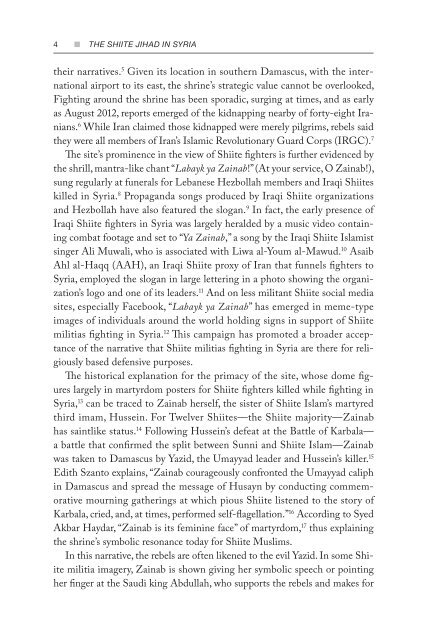You also want an ePaper? Increase the reach of your titles
YUMPU automatically turns print PDFs into web optimized ePapers that Google loves.
4 n <strong>THE</strong> <strong>SHIITE</strong> <strong>JIHAD</strong> <strong>IN</strong> <strong>SYRIA</strong><br />
their narratives. 5 Given its location in southern Damascus, with the international<br />
airport to its east, the shrine’s strategic value cannot be overlooked,<br />
Fighting around the shrine has been sporadic, surging at times, and as early<br />
as August 2012, reports emerged of the kidnapping nearby of forty-eight Iranians.<br />
6 While Iran claimed those kidnapped were merely pilgrims, rebels said<br />
they were all members of Iran’s Islamic Revolutionary Guard Corps (IRGC). 7<br />
The site’s prominence in the view of Shiite fighters is further evidenced by<br />
the shrill, mantra-like chant “Labayk ya Zainab!” (At your service, O Zainab!),<br />
sung regularly at funerals for Lebanese Hezbollah members and Iraqi Shiites<br />
killed in Syria. 8 Propaganda songs produced by Iraqi Shiite organizations<br />
and Hezbollah have also featured the slogan. 9 In fact, the early presence of<br />
Iraqi Shiite fighters in Syria was largely heralded by a music video containing<br />
combat footage and set to “Ya Zainab,” a song by the Iraqi Shiite Islamist<br />
singer Ali Muwali, who is associated with Liwa al-Youm al-Mawud. 10 Asaib<br />
Ahl al-Haqq (AAH), an Iraqi Shiite proxy of Iran that funnels fighters to<br />
Syria, employed the slogan in large lettering in a photo showing the organization’s<br />
logo and one of its leaders. 11 And on less militant Shiite social media<br />
sites, especially Facebook, “Labayk ya Zainab” has emerged in meme-type<br />
images of individuals around the world holding signs in support of Shiite<br />
militias fighting in Syria. 12 This campaign has promoted a broader acceptance<br />
of the narrative that Shiite militias fighting in Syria are there for religiously<br />
based defensive purposes.<br />
The historical explanation for the primacy of the site, whose dome figures<br />
largely in martyrdom posters for Shiite fighters killed while fighting in<br />
Syria, 13 can be traced to Zainab herself, the sister of Shiite Islam’s martyred<br />
third imam, Hussein. For Twelver Shiites—the Shiite majority—Zainab<br />
has saintlike status. 14 Following Hussein’s defeat at the Battle of Karbala—<br />
a battle that confirmed the split between Sunni and Shiite Islam—Zainab<br />
was taken to Damascus by Yazid, the Umayyad leader and Hussein’s killer. 15<br />
Edith Szanto explains, “Zainab courageously confronted the Umayyad caliph<br />
in Damascus and spread the message of Husayn by conducting commemorative<br />
mourning gatherings at which pious Shiite listened to the story of<br />
Karbala, cried, and, at times, performed self-flagellation.” 16 According to Syed<br />
Akbar Haydar, “Zainab is its feminine face” of martyrdom, 17 thus explaining<br />
the shrine’s symbolic resonance today for Shiite Muslims.<br />
In this narrative, the rebels are often likened to the evil Yazid. In some Shiite<br />
militia imagery, Zainab is shown giving her symbolic speech or pointing<br />
her finger at the Saudi king Abdullah, who supports the rebels and makes for


